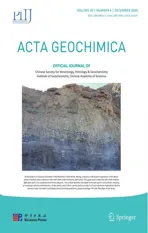Zircon U-Pb geochronology, whole-rock geochemical,and Sr-Nd-Pb isotopic constraints on the timing and origin of Permian and Triassic mafic dykes from eastern North China Craton
2021-01-09ShenLiuCaixiaFengYanFanXiaoqingChenYuhongYangHuiboZhaoIanCoulson
Shen Liu · Caixia Feng · Yan Fan · Xiaoqing Chen · Yuhong Yang ·Huibo Zhao · Ian M. Coulson
Abstract This work reports an important episode of extensional, mafic magmatism that impacted the North China Craton (NCC) during the Permo-Triassic and influenced the evolution of this Craton. We sampled 30 representative mafic dykes cropping out in eastern NCC, within the Hebei Province, China. New zircon LA-ICP-MS U–Pb ages, geochemical, and Sr–Nd–Pb isotopic data for these mafic dykes identified them as typical dolerites formed between 211.9 ± 1.3 and 263.9 ± 2.6 Ma. The mafic rocks fall into the alkaline and calc-alkaline series. They are enriched in light rare earth elements, some large ion lithophile elements (e.g., Rb, Ba, and Sr), K, and Pb, and depleted in Nb, Ta, and Ti. The dykes have high initial 87Sr/86Sr ratios (0.7034–0.7178), negative εNd (t) values(-2.2 to -5.9), and relatively constant initial Pb isotopic ratios, that are EM1-like: (206Pb/204Pb)i = 16.39–16.74,(207Pb/204Pb)i = 15.22–15.24, and (208Pb/204Pb)i-= 36.66–36.86, respectively. Our results indicate that the Hebei Province dolerites were likely derived from magma generated through low-medium degree partial melting(3.0–20%)of an EM1-like garnet-lherzolite mantle source.The parental magmas fractionated olivine, clinopyroxene,and Ti-bearing phases with obvious crustal contamination during rapid ascent and dyke emplacement. Since the possible influence of subduction of the Yangtze Plate has been excluded, we propose a model for the origin of the investigated mafic rocks, involving the Permian collision between the Siberian Block and the NCC.The mafic dykes of eastern NCC within Hebei Province formed during a period of crustal thinning in response to extension after the early Permian collision.
Keywords Permo-Triassic · Dolerite · Origin · NCC ·Siberian block
1 Introduction
As a fundamental process of the evolution of the Earth,basic or mafic magmatism has been especially important in the development of ancient continental nuclei(Jahn 1990).For example, mafic rocks that occur in the eastern Hebei Province of China form part(termed the Eastern Block) of the North China Craton or NCC, one of Asia’s oldest continental masses. The Eastern Block’s amalgamation with two other Archean terranes, the Middle tectonic Belt and the Western Block, provides a record within its varied lithologies key intervals of collisional and subsequent extensional tectonics,as the NCC was punctuated by mafic magmatism that accompanied such upheavals in its protracted evolution(Shen et al.1994; Zhao et al.2001; Shao et al.2002;Kusky and Li 2003;Liu et al.2004,2013a,b).For this reason, there should be attendant changes in the style or character of magmatism related to distinct periods of lithospheric stretching. The NCC will provide an unrivaled opportunity to identify, observe, and study such anomalies and elucidate reasons for these differences(e.g.,delamination of a lithospheric keel; Liu et al. 2009).
As a principal record of magmatism in the context of lithospheric extension, mafic dykes and their emplaced swarms that occur across the NCC provide a key opportunity to learn more about the processes attending stretching in this part of Asia,and of the partial melting of the mantle, be these magmas sourced in either lithosphere or asthenosphere, as well as, any influence from crustal assimilation during magma ascent and dyke emplacement(Liu et al. 2006, 2008a, b, 2009, 2010, 2012, 2013a, b).
China’s mafic dyke swarms chiefly occur in the east;many reside within the NCC, where at present, over 500 hundred NE–NW–WE-trending mafic dykes have been recorded (Liu et al. 2004, 2006, 2008a, b, 2009, 2009,2010,2012,2013a,b,2016,2017,2018).While the bulk of the NCC mafic dykes were emplaced in the Precambrian(2.4–2.6, 2.1–2.3, 1.9, 1.6–1.8, 1.4, 1.3–1.0, 0.6–0.8 Ga),an important episode of mafic magmatism also occurs in the Upper Mesozoic (after the Jurassic) (Chen et al. 1992;He et al. 1993; Li et al. 1997, 2001, 2010, 2018; Shao and Zhang 2002; Shao et al. 2002, 2003, 2005; Yang et al.2004; Liu et al. 2004, 2006, 2008a, b,2009,2009,2010,2012,2013a,b,2016,2017,2018;Peng et al. 2005, 2007, 2008, 2010, 2011a, b, 2018; Hou et al.1994, 1998, 2005, 2006; Wang et al. 2007, 2016; Hou 2012;Yan et al.2007;Wu et al.2008;John et al.2010;Hu et al. 2010; Feng 2012; Feng et al. 2012; Yang et al.2012, 2013a, b, 2017; Yang 2013; Tang 2013; Zhao 2014;Peng 2015; Guo et al. 2016). Mafic dykes have been reported to occur outside of these two main periods of magmatism(e.g.,dykes of Permian and Triassic age in the northern NCC) although little attention has been paid to these due to poor exposure (Regional Geological Records of Jilin Province 1988; Regional Geological Records of Liaoning Province 1989; Regional Geological Records of Inner Mongolia Autonomous Region 1991; Regional Geological Records of Beijing 1991; Regional Geological Records of Hebei Province 1989; Regional Geological Records of Shandong Province 1991; Regional Geological Records of Henan Province 1989; Regional Geological Records of Shaanxi Province 1989; Regional Geological Records of Shanxin Province 1989; Regional Geological Records of Gansu Province 1989; Miao et al. 2008; Liu et al. 2010, 2013a, b, 2014; Zhang et al. 2010, Feng et al.2010; Chen et al. 2012). To better characterize these Permo-Triassic occurrences, we carried out a study of representative eastern NCC mafic dykes from the Hebei Province.Our investigation included the collection of laser ablation-inductively coupled plasma-mass spectrometry(LA-ICP-MS) zircon U–Pb geochronology, whole-rock petrology, geochemical, and Sr–Nd–Pb isotopic data for these samples.These data helped to constrain the timing of dyke emplacement and the origin of the Permo-Triassic mafic dykes. In doing so, we can examine their influence on the long-term development of the NCC, in the context of other episodes of extensional magmatism affecting this Craton.
2 Geological setting and dyke petrology
The NCC is bounded to the south by the Paleozoic to Triassic Qinling–Dabie–Sulu Orogenic Belt(Li et al.1993;Meng and Zhang 2000; Zhang et al. 2003a, b; Dong and Santosh 2016) and to the north by the Central Asian Orogenic Belt (Davis et al. 2001). The Eastern Block in the NCC comprises the Longgang and Langrim blocks, separated by the Paleoproterozoic Jiao–Liao–Ji Belt (Li et al.2006; Li and Zhao 2007; Zhou et al. 2008; Zhao et al.2010,2012;Tam et al.2012a,b;Zhao and Zhai 2013).The Western Block comprises the Yinshan Block in the north and the Ordos Block to the south, separated by the E–Wtrending Inner Mongolia Suture Zone, also known as the Khondalite Belt (Xia et al. 2008; Yin et al. 2009, 2011; Li et al. 2011; Wang et al. 2011; Santosh et al. 2012). While the cratonic lithosphere of the Western Block has been relatively stable since Precambrian times, the Eastern Block of the NCC has experienced extensive magmatic activity following cratonisation (Zhang et al. 2003a, b).
The presently recorded distribution of Permian and Triassic mafic dyke swarms in the NCC is relatively limited, with Permo-Triassic swarms chiefly occurring in the Jilin, Shaanxi, and Hebei provinces (Miao et al. 2008; Liu et al. 2010, 2013a, b; Zhang et al. 2010, Feng et al. 2010;Chen et al. 2012). In our work, we have focused on study areas within the Jiazhitou, Liangjiazhuang, Xiaowuying,Chongjiabao, and Tangchikou regions of the eastern NCC,in the Hebei Province (Fig. 1). In these areas occur mafic dykes, covering the following periods of magmatic activity: 212, 262, 263, and 264 Ma (Table 1; Fig. 4). The country-rock lithologies to these dykes are granite, monzonite, and sedimentary rocks (Fig. 1). In general, individual examples of the mafic dykes as studied are nearvertical, of strike NE-SW and E-W (Fig. 2), and between 0.2 and 0.8 km in width, with lengths of 0.2–1.3 km(Fig. 2). The rocks are fresh at outcrop, dark grey, and exhibit massive to doleritic textures.Rock petrography has the major mineral constituents to be slender,columnar and euhedral plagioclase and clinopyroxene (48 and 43 vol.%,respectively), with accessory opaque phases; minor interstitial quartz was observed (Fig. 3).

Fig. 1 Schematic illustration showing the distribution of mafic dykes throughout the Hebei Province, NCC



Fig. 2 Field geological photographs of the Hebei Province study areas
In terms of area-specific detail, the dolerite dykes at Jiazhitou were emplaced into Cambrian units, striking NW–SE and E–W, with widths of 0.2–0.6 km and lengths of 0.1–1.0 km (Fig. 1). They comprise phenocrysts of clinopyroxene and plagioclase(together constituting 33–35 vol.%), and minor biotite microphenocrysts (0.5–1.3 mm)within a groundmass (~65–70%) of pyroxene, plagioclase, magnetite, and chlorite (Figs. 2 and 3). The mafic/dolerite dykes studied within the Liangjiazhuang and Xiaowuying areas are mostly emplaced into Archaean units. These 0.3–0.8 km wide and 0.2–1.2 km long dykes strike NE–SW,and E–W(Fig. 1).They contain 30–35%of clinopyroxene and plagioclase phenocrysts, with minor biotite microphenocrysts (0.4–1.2 mm) (total 30–35 vol.%),set within a groundmass(~60–63%)of pyroxene,plagioclase, and magnetite (Figs. 2 and 3). Dolerite dykes from the Chongjiabao area were also emplaced into Archaean units. These are sub-alkalic, striking NE–SW,and E–W, and have widths of 0.3–0.8 km and lengths of 0.2–1.3 km(Fig. 1).They are characterized by phenocrysts of clinopyroxene, plagioclase, and minor biotite (microphenocrysts, 0.5–1.3 mm) (for a total of 30–35 vol.%),within a groundmass (~60 %) of pyroxene, alkali feldspar, plagioclase, and magnetite (Figs. 2, 3). Mafic dykes from Tangchikou were also emplaced into Archaean lithologies. These are alkalic, striking NW–SE, and E–W,and 0.1–0.6 km wide and 0.3–1.2 km long (Fig. 1). They contain microphenocrysts (0.5–1.2 mm) of clinopyroxene,plagioclase,and minor biotite(total 30–35 vol.%)within a groundmass (~65–70%) of pyroxene, alkali feldspar,plagioclase, magnetite, and chlorite (Figs. 2, 3).
3 Analytical procedures
3.1 U-Pb dating by LA-ICP-MS methods
Zircon from five of the investigated Hebei Province mafic dyke samples was separated using conventional heavy liquid and magnetic techniques. Representative zircon grains were then hand-picked under a binocular microscope before being mounted in an epoxy resin disc, polished, and then coated with gold, prior to the analysis.Individual crystals were studied using optical microscopy techniques and under cathodoluminescence (CL) to aid in characterization and to reveal any internal features. CL imaging(Fig. 4)and U–Pb analysis were undertaken at the State Key Laboratory of Continental Dynamics. Theanalytical procedures were described in detail in Harris et al. (2004). A spot diameter of 29 μm was used. U–Th–Pb ratios and absolute abundances were determined by reference to replicate measurements of a standard TEMORA zircon and the NIST 610 glass standard.

Fig. 3 Representative photomicrographs illustrating the petrography of mafic dykes from the Eastern NCC within the Hebei Province, China; all samples have doleritictectures and hence are termed dolerite dykes. Cpy clinopyroxene, Pl plagioclase
3.2 Major elemental and trace elemental analyses
Major element compositions were determined using an analytical Axioms-advanced X-ray fluorescence (XRF)spectrometer at the State Key Laboratory of Ore Deposit Geochemistry (LODG) with an analytical precision of better than 5 %. Trace element compositions were determined by Inductively coupled plasma mass spectrometry(ICP-MS) utilizing a Perkin-Elmer ELAN DRC-e instrument at the LODG. Prior to analysis, powdered samples(50 mg) were dissolved in high-pressure Teflon bombs,using an HF + HNO3acid attack for 48 h at a temperature of ~190 °C (Qi et al. 2000). Signal drift was monitored during the analysis by reference to an Rh internal standard.GBPG-1, OU-6, GSR-1, and GSR-3 standards were additionally used for analytical quality control with a determined analytical precision of better than 5 %.
3.3 Sr-Nd-Pb isotopic analyses

Fig. 4 Zircon cathodoluminescence(CL)images for separated grains within the mafic dykes from the NCC study areas,and corresponding LAICP-MS U–Pb concordia diagrams
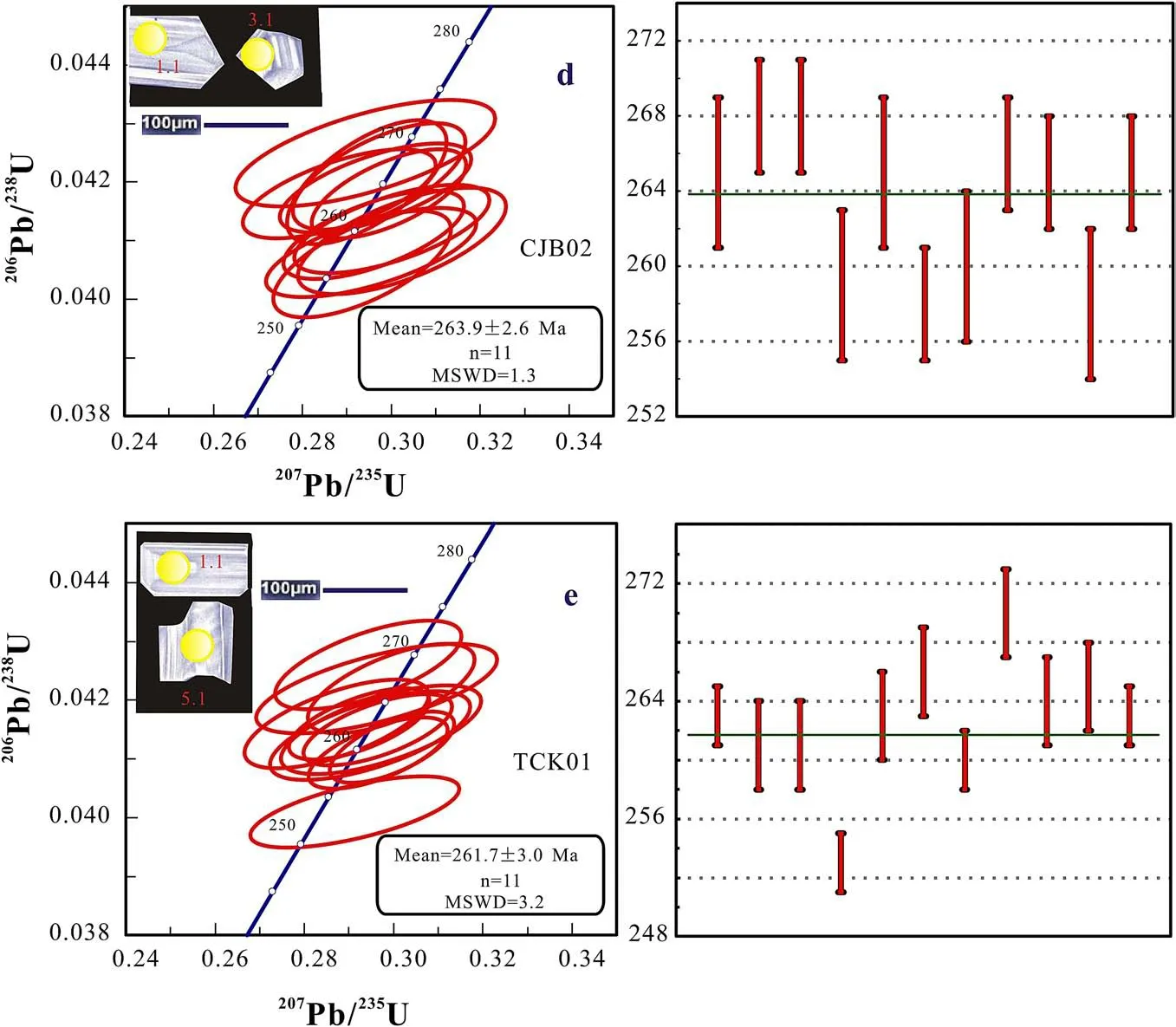
Fig. 4 continued
For Rb–Sr and Sm–Nd isotope analyses, sample powders were spiked with mixed isotope tracers, following dissolution with HF + HNO3acids (in Teflon bombs). The isotopes were separated by conventional cation-exchange techniques.Isotopic measurements were performed using a Finnigan Triton Ti thermal ionization mass spectrometer(TIMS) at the LODG. Procedural blanks yielded concentrations of <200 pg for Sm and Nd, and <500 pg for Rb and Sr,respectively.The mass fractionation corrections for Sr and Nd isotopic ratios were based on86Sr/88Sr = 0.1194 and146Nd/144Nd = 0.7219.Analysis of the NBS987 and La Jolla standards yielded the following results:87Sr/86Sr = 0.710246 ± 16 (2σ), and143Nd/144Nd = 0.511863 ± 8(2σ),respectively.Before Pb isotopic analysis, Pb was separated and purified by conventional cation-exchange techniques,using diluted HBr as an eluent. Analysis of the NBS981 standard yielded mean values for204Pb/206Pb of 0.0896 ± 15,207Pb/206Pb of 0.9145 ± 8, and208Pb/206Pb of 2.162 ± 2.
4 Results
4.1 Zircon U-Pb geochronology
Clean, prismatic grains of euhedral zircon in samples JZT01, LJZ02, XWY01, CJB02, and TCK01 display oscillatory zoning, suggesting that these were the products of a crystallizing magma. A total of 12 zircon grains provided a weighted mean206Pb/238U age of 211.9 ± 1.3 Ma(1σ)(95%confidence interval,MSWD = 0.13)for JZT01;13 zircon grains gave a weighted mean206Pb/238U age of 262.5 ± 1.3 Ma (1σ) (95% confidence interval,MSWD = 0517) for LJZ02; 13 grains gave a weighted mean206Pb/238U age of 262.6 ± 1.4 Ma (1σ) (95%confidence interval,MSWD = 0.39)for XWY01;11 grains have a weighted mean206Pb/238U age of 263.9 ± 2.6 Ma(1σ) (95% confidence interval, MSWD = 1.3) for CJB02,and 11 grains provided a weighted mean206Pb/238U age of 261.7 ± 3.0 Ma (1σ) (95 % confidence interval,MSWD = 3.2) for TCK01 (Table 1; Fig. 4). These determinations are the best estimates for the crystallization ages of the investigated mafic dykes from the NCC.No inherited zircon characteristics were observed in the investigated sample populations.
4.2 Major and trace elements
Whole-rock geochemical data for the studied Hebei Province mafic dykes are presented in Tables 2 and 3. The dolerite samples exhibit a fairly wide range of compositions: SiO2(46.41–51.98 wt%), TiO2(1.27–2.64 wt%),Al2O3(13.33–15.95 wt%), Fe2O3(8.96–14.57 wt%), MnO(0.08–0.23 wt%),MgO(3.48–8.96 wt%),CaO(4.53–13.24 wt%),Na2O(1.61–3.42 wt%),K2O(1.96–4.01 wt%),P2O5(0.10–0.67 wt%), and Mg#(40–68), and a relatively small loss of ignition(LOI 0.86–3.76)(Table 2).All samples fall into the alkaline and calc-alkaline field in terms of the total alkali-silica diagram (Fig. 5). The mafic dykes exhibit irregular correlations between SiO2, TiO2, Al2O3, Fe2O3,CaO, Na2O, K2O, P2O5, and MgO (Fig. 6a–h). The samples are also characterized by LREE enrichment and HREE depletion, with a narrow range of Eu/Eu* (0.93–1.06)(Table 3 and Fig. 7a, b). On primitive mantle-normalized trace element diagrams,the Hebei Province dolerites show enrichment in LILEs (i.e., Rb, Ba, Sr), K, and Pb, and depletion for HFSEs (i.e., Nb, Ta, Hf, and Ti) (Fig. 7b).
4.3 Sr-Nd-Pb isotopes
Sr, Nd, and Pb isotopic data for 30 representative Hebei Province dolerites are presented in Tables 4,5,and Figs. 8 and 9a, b. These mafic dykes exhibit a wide range in (87-Sr/86Sr)ivalues of between 0.7034 and 0.7178 and wide variation in εNd(t) values, from - 2.2 to - 5.9, which is suggestive of source areas with slight enrichment.The mafic rocks display relatively constant Pb isotopic ratios that are EM1-like, (206Pb/204Pb)i= 16.39–16.74,(207Pb/204Pb)i= 15.22–15.24, and (208Pb/204Pb)i= 36.66–36.86.
5 Discussion
5.1 Mantle source
The dolerites studied from the Eastern NCC within Hebei Province (212–264 Ma) contain lower values of SiO2(46.41–51.98 wt%)than liquids produced partial melting of any crustal rock(i.e.,which would instead produce granitic liquids; Hirajima et al. 1990; Kato et al. 1997; Gao et al.1998a,b;Rapp et al.2003).Moreover,as partial melting of any crustal material (e.g., Hirajima et al. 1990; Kato et al.1997) or lower crustal intermediate granulites in the deep crust (Gao et al. 1998a, b) would produce melts high in Si and low in Mg(i.e.,granitoid liquids;Rapp et al.2003),the determined compositions for the investigated Hebei Province dolerite dykes,suggest that these dykes formed from a mantle-rather than a crust-derived magma.This inference is also supported by the fact that these mafic rocks have relatively higher MgO concentrations (almost greater than 5.25 wt%), Zr/Nb ratios (almost greater than 13.0), and elevated Mg#(almost greater than 48), although they were characterized by relatively low concentrations of Cr(112–355 ppm) and Ni (61–215 ppm; Table 3). Furthermore, high initial87Sr/86Sr ratios (0.7034–0.7178) and negative εNd(t) (from - 2.2 to - 5.9) for the mafic rocks(Table 4;Fig. 8)are fully consistent with derivation from a relatively enriched lithospheric mantle source, rather than from an asthenosphere source with a depleted Sr–Nd isotopic composition. Such an enriched mantle source is present beneath the NCC study area (e.g., for the Shaanxi Province, Hebei Province, and SongliaoBasin (87Sr/86Sr)i = 0.7049–0.7092,and εNd(t)is between- 4.1 and- 5.9;Liu et al.2010,2013a,b;Zhang et al.2010).Nevertheless,this differs from the source of Triassic mafic dykes found elsewhere in the NCC,and especially those from within the Shanxi Province (Zhang et al. 2010; Liu et al.2013a, b, 2014).
An enriched lithospheric mantle source is further supported for the Hebei Province dolerites in their EM1-like Pb isotopic compositions ((206Pb/204Pb)i= 16.39–16.74,(207Pb/204Pb)i= 15.22–15.24, and (208Pb/204Pb)i-= 36.66–36.85) (Table 5; Fig. 9a, b). Moreover, determined La/Sm and Sm/Yb for the studied mafic rocks (see Table 3; Fig. 10a, b) are consistent with these magmas having been generated by relatively low to moderate degree partial melting (3.0%–20%) of a garnet lherzolite source;a feature that is also reflected in high Ti/Y and(La/Yb)Nratios (242–450, 20–38; Tables 2 and 3) for the Hebei Province dykes.

Table 2 Whole-rock major element (wt %) composition results for the studied dolerites from the Eastern NCC within Hebei Province, China
5.2 Crustal contamination
Generally, crustal contamination might cause a significant depletion in the ratio of Nb–Ta,and possible enrichment in the Sr–Nd isotopic signatures of basaltic rocks. The Hebei Province mafic dykes studied herein are characterized by negative Nb–Ta anomalies (Table 3; Fig. 7b), relatively high Sr isotopic compositions (0.7034–0.7178) and negative εNd(t) (from - 2.2 to - 5.9) (Table 4; Fig. 8); such geochemical characteristics as mentioned above might imply a crustal component in the development of the mafic dykes investigated and/or their parental magmas. Additional support in favor of crustal contamination is evident in the low Nb/U (5.7–19; Table 3) (cf. Nb/U = 9.0–21 for the crust, and Nb/U = 47 for primitive mantle), Ta/La ratios (0.01–0.05; Table 3) (cf. Ta/La = 0.06 for primitive mantle), the observed positive correlation between MgO and εNd(t) values, and a negative correlation observed between MgO and initial87Sr/86Sr ratios (Table 4; not shown). Furthermore, the studied Hebei Province mafic dykes are characterized by relatively higher Th(2.21–6.67 ppm), Nb (5.37–17.0 ppm), and U(0.53–1.44 ppm) contents (Table 3), Zr/Hf(24.8–52.5 ppm), Th/U (3.52–4.90 ppm), Sr/Nd(22.0–70.8 ppm), Sm/Nd (0.12–0.28 ppm), and Eu/Eu*(0.90–1.08) ratio, when compared to whole crust values(e.g., Th = 5.6 ppm, Nb = 12 ppm, U = 1.42 ppm, Zr/Hf = 33, Th/U = 3.9, Sr/Nd = 16, Sm/Nd = 0.19, Eu/Eu* = 0.96; Rudnick and Fountain 1995), implying that different degrees crustal contamination occurred during the genetic process for the mafic dykes studied,although there was no inherited zircon in the Hebei Province samples.This is further by the relatively higher Sr isotopic compositions(0.7034–0.7178)due to the possible fractionation(Liu 1991).


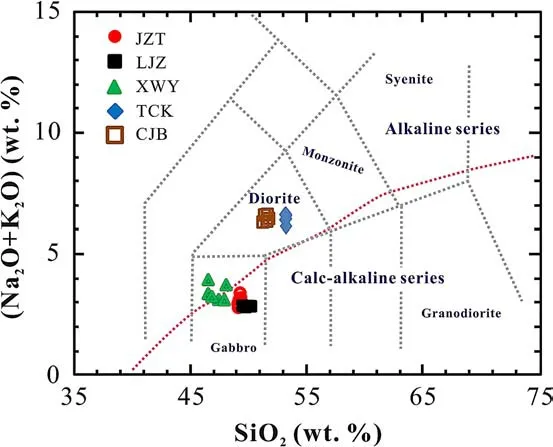
Fig. 5 Total alkali versus silica (TAS) plot for the mafic dykes from Eastern NCC within the Hebei Province, China. All major element data have been re-calculated to 100% on an anhydrous basis(Middlemost 1994)
5.3 Fractional crystallization
Our determined geochemical data provide important constraints of the differentiation of the Hebei Province mafic rocks. The observed high Mg#(almost greater than 48) for the investigated samples is inconsistent with their significant crystal fractionation. However, the Hebei Province mafic dykes contain low Cr (almost all less than 240 ppm,except for seven dolerite samples) and Ni (61–112 ppm,except for six dolerite samples; Table 3) contents, suggestive that they represent fractional crystallization products.The separation of Ti-bearing oxides and apatite is also supported in the negative Nb, Ta, and Ti anomalies observed on primitive mantle-normalized spider diagrams(see Fig. 7b). Additional support for this are given in the correlative plots of MgO versus (87Sr/86Sr)i, εNd(t) and(206Pb/204)i(not shown), and the observed correlation between MgO and SiO2, TiO2, Al2O3, Fe2O3, CaO, Na2O,K2O, and P2O5(Fig. 6a–h), that favors fractionation of olivine,clinopyroxene,and phases,such as rutile,ilmenite,or titanite, in their genesis.
A plausible explanation to account for the minimal effects of both crustal assimilation and magmatic differentiation could relate to the rapid pace of crustal extension,which would limit residency of new mafic magmas in the crust, which in turn inhibited crustal melting and magma mixing to favor the ascent and emplacement of mafic magmas largely unmodified (cf. Searchlight Magmatic System of Northern Colorado; Faulds et al. 2018).
5.4 Genetic model
It is generally accepted that the igneous rocks from the Hebei Province have a relatively complex genetic model, in part reflecting its special geographical position within the NCC.At present,there are four possible models to account for the origin of Paleozoic mafic magmatic activities in the NCC.These relate either to:the subduction of the Yangtze Crust,the Siberian Craton and/or the ancient Pacific beneath the NCC; and the successive hybridism of foundered lower crust.Below we discuss and/or discount the significance of each of the above possibilities in the genesis of the mafic magmas occurring in the Permian and Triassic.
First of all,the Hebei Province mafic dykes studied here are characterized by Pb isotopic signatures that are similar to those of the Paleozoic mafic rocks from the NCC (Jia and Guo 1993; Zhang 1998; Zhang et al. 2007a, b, 2010;Shi et al. 2014), but which differ from those of the mafic rocks within the Yangtze Craton (Figs. 5, 6, 7a). Also,there was no westward subduction of the ancient Pacific Plate below the NCC before the early Cretaceous. Both rule out the involvement of Yangtze Craton and ancient Pacific material in the genesis of the Permo-Triassic mafic dykes in the Hebei Province. This conclusion is further supported by the fact that the subducting Yangtze lithosphere and the ancient Pacific Plate did not contribute to the source of the magmas (>240 Ma) formed within the NCC (Engebretson et al. 1985; Xu et al. 1993; Shen et al.1994; Zhang et al. 2005; Zhang and Sun 2002; Hu et al.2004;Liu et al.2008a,b,2009,2012,2013a,b,2015;Guo et al.2014).By contrast,the collision between the Siberian Block and the NCC (i.e., 290–250 Ma; Miyashiro 1981;Zhang et al. 2008; Zhou et al. 2010) can be considered as an influencing factor, though the timing of events is still controversial (Miyashiro 1981; Tang 1990; Shao 1991;Wang et al. 1991; Hong et al. 1994; Zhang et al.2007a, b, 2008, 2010; Miao et al. 2008; Luo et al. 2009;Feng et al. 2010; Chen et al. 2012). Based upon the above evidence, the origin of the dolerites studied herein could relate to the earlier evolution of the NCC during the Paleozoic, implying the Hebei Province mafic dykes as studied were derived through the partial melting of an enriched mantle source below the NCC; nevertheless, it is unclear how the enriched source was formed beneath the study area.
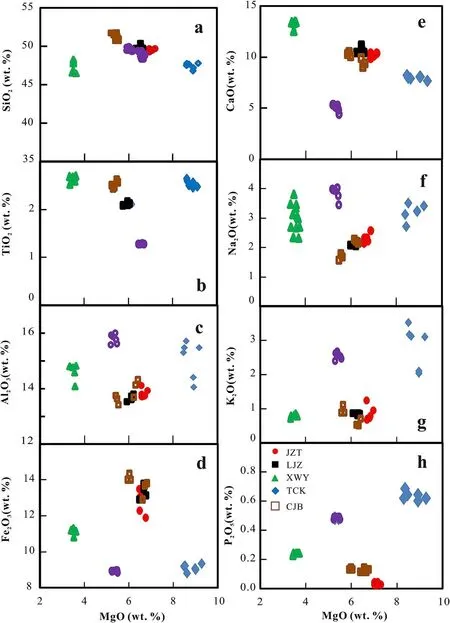
Fig. 6 SiO2, TiO2, Al2O3, F2O3, CaO, Na2O, K2O, and P2O5 versus MgO plots for the mafic dykes from Eastern NCC within the Hebei Province, China

Fig. 7 Chondrite-normalized REE diagrams and primitive mantlenormalized element distribution spider-diagrams for the mafic dykes from the Eastern NCC within the Hebei Province, China. The normalization values are from Sun and McDonough (1989)
As an important geological phenomenon influencing crust-mantle exchange,delamination currently has become a favored process in key crust-mantle exchange; it has attracted the attention of geologists, geophysics and geochemists which envisage gravitational instability as a major driving force of delamination(Gao and Jin 1997;Gao et al.1998a;Liu et al.2008a,b,2009,2012,2013a,b).Its direct consequence is that the lithospheric mantle and lower crust sink into the asthenosphere and hot asthenospheric material flows up to the lower crust to replace the foundered cold upper mantle. Moreover, lithospheric thickening is a prelude to the foundering of the continental lithosphere and the lower crust. Thickening of the lithosphere will induce metamorphism of the mafic lower crust, which will likely lead to the formation of eclogite.The high density(0.2–0.4 g cm-3) and lower melting temperatures (<1200 °C) of eclogite (Rudnick and Fountain 1995; Yaxley and Green 1998; Rapp et al. 1999; Yaxley 2000; Jull and Kelemen 2001; Kogiso et al. 2003; Sobolev et al. 2005; Anderson 2006; Levander et al. 2006; Liu et al. 2017) can lead to gravitational instability in this part of the lithosphere,resulting in the foundering of eclogite into the asthenosphere below (Arndt and Goldstein 1989; Kay and Kay 1991; Jull and Kelemen 2001; Gao et al. 2004). Accommodation and space constraints require the upwelling of an equal amount of hotter and low-density materials from the asthenosphere; in other words, there is material exchange among the asthenosphere, lithospheric mantle, and crust,commonly accompanied by lithospheric extension and thinning, and subsequent mountain building/uplift, basin formation and other large-scale, intracontinental magmatic activities (Bird 1978, 1979; Gao and Jin 1997, Gao et al.1998a; Liu et al. 2008a, b, 2009, 2012, 2013a, b). Additionally, it is generally accepted that any foundered eclogite, that is commonly silica-saturated can thereafter melt to produce olivine-free pyroxenite melts that may variably hybridize with overlying mantle peridotite material. Such a hybridized mantle may undergo additional melting to generate basaltic melts (Kogiso et al. 2003;Sobolev et al. 2005; Gao et al. 2008).
Based on the above discussion,a scenario to account for the origin of the Hebei Province mafic dykes is presented.It is generally accepted that the collision between the Siberian Block and the NCC occurred during the late Paleozoic (i.e., 290–250 Ma), a led to both crustal thickening and eclogitization of the lower crust (Zhang et al.2002; Liu et al. 2017). Before 290 Ma, the Siberian Block and the NCC were two relatively independent geological bodies (Fig. 11a, b). Between 290 and 250 Ma, the collision between Siberian Block and the NCC resulted in thickening of the lithospheric mantle beneath both Siberian Block and the NCC. The thickened lithosphere induced deformation and regional metamorphism, as well as the formation of ophiolite due to the transformation of supracrustal rock present (Fig. 11b). Owing to the gravitational imbalance of the me`lange, the foundering of the lithospheric mantle into the underlying asthenosphere occurred(Fig. 11c).Subsequently,the lithosphere stretches allowing for hot, asthenospheric material to rising, which induces partial melting of the lithosphere and ascending asthenosphere.The mixing of magmas from these sources resulted in the parent magmas to the Hebei Province mafic dykes,with these being emplaced along fractures and faults generated through lithospheric extension. Following a certain degree of fractional crystallization, the Hebei Province study area mafic dyke swarms were emplaced. Support for this genetic model is given in the relatively low contents of Sc (16.8–46.6 ppm), Cr (114–375 ppm), and Ni(61.3–215 ppm) (Table 3; Fig. 7b), voluminous coeval(296–250 Ma) magmatic activities (Jia and Guo 1993;Zhang 1998; Zhang et al. 2007a, b, 2010; Shi et al. 2014),large-scale mineralization typical of this region(Hart et al.2002;Zhang et al.2003a,b;Cook et al.2009;Wang 2011),and the local occurrence of adakite in Hebei Province(Zhang et al. 2003a, b, 2009; Wang 2011; Chen et al.2013).
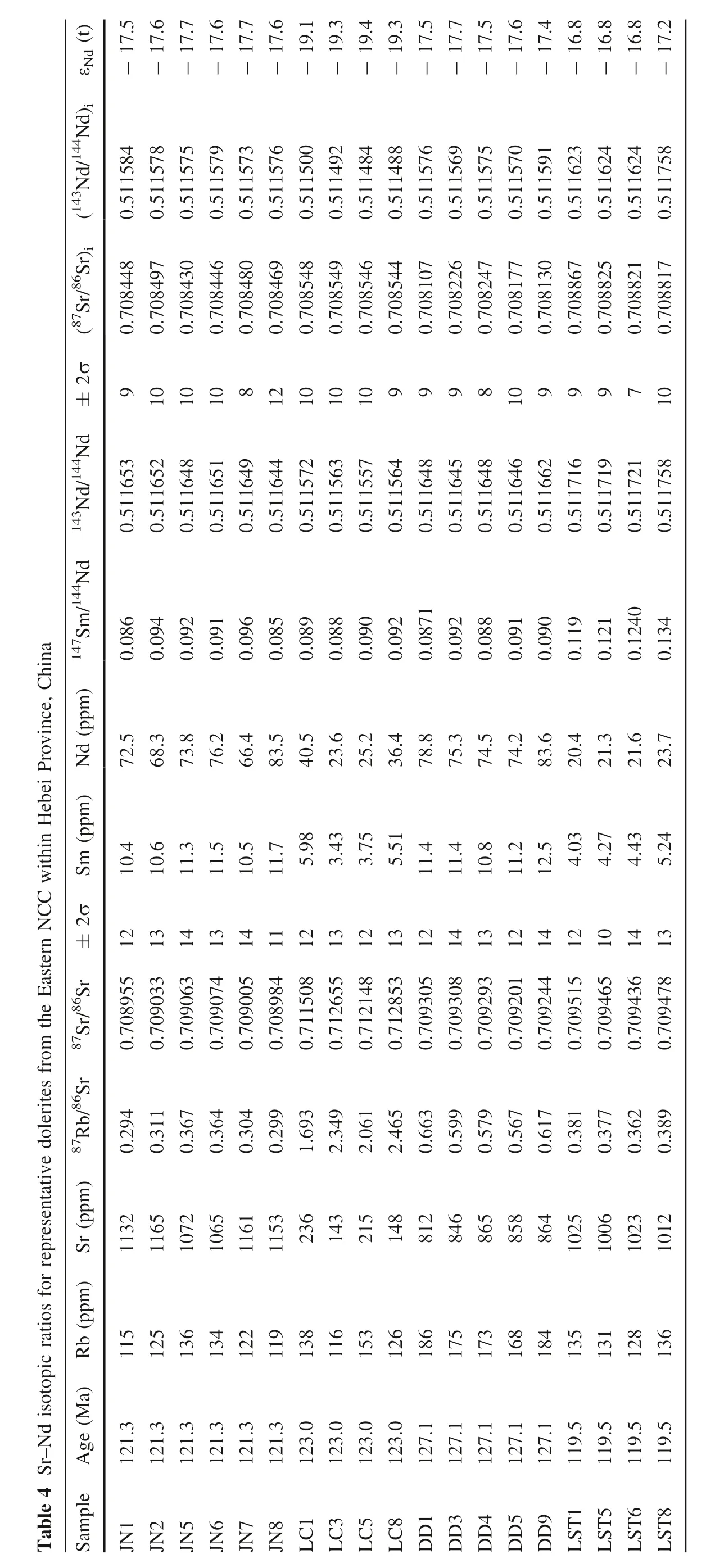


Fig. 8 Initial 87Sr/86Sr versus εNd (t) diagram for the mafic dykes from the Eastern NCC within Hebei Province, China

Fig. 9 208Pb/204Pb and 207Pb/204Pb versus 206Pb/204Pb diagrams for the mafic dykes from the Eastern NCC within Hebei Province,China.Fields for I-MORB (Indian MORB) and P&N-MORB (Pacific and North Atlantic MORB), OIB, NHRL and 4.55 Ga geochron are after Barry and Kent (1998), and Hart (1984), respectively
6 Conclusions
Integrated zircon U–Pb geochronology, whole-rock geochemistry,and Sr–Nd–Pb isotopic studies of suites of mafic dykes from the eastern NCC within Hebei Province allow us to draw the following conclusions.

Fig. 10 La versus La/Sm(a)and Sm versus Sm/Yb diagrams for the mafic dykes from the Eastern NCC within Hebei Province, China
1. The mafic/dolerite dykes from the study area were intruded during the Permian and Triassic as evidenced in the newly determined zircon U–Pb geochronological ages, of 211.9 ± 1.3 and 263.9 ± 2.6 Ma.
2. All mafic rocks studied have an affinity to alkaline and calc-alkaline igneous suites. These are enriched in LREE, and select LILE (e.g., Rb, Ba, and Sr), K, and Pb, and depleted in Nb, Ta, and Ti relative to a primitive mantle.The dykes have high initial87Sr/86Sr ratios (0.7034-0.7178), negative εNd(t) values (from- 2.2 to - 5.9), and relatively constant Pb isotopic ratios (that are EM1-like, (206Pb/204Pb)i-= 16.39–16.74, (207Pb/204Pb)i= 15.22–15.24, and(208Pb/204Pb)i= 36.66–36.86). These data suggest that the magmas parental to dolerite were generated as lowmedium degree partial melts (3.0–20%) of an EM1-like garnet Iherzolite mantle source. A certain degree fractionation of olivine,clinopyroxene,and Ti-bearing phases occurred during rapid magma ascent, with obvious crustal contamination.
3. Based on this study, we propose that the mafic dykes(264–211 Ma) were associated with post-collisional relaxation, which promoted the upwelling of the asthenospheric mantle. This rising hot mantle led to elevated geotherms in the overlying lithospheric mantle, which, in response, underwent decompression partial melting,yielding the parental melts to the Hebei Province mafic dykes. Extensional tectonics also facilitated crustal thinning and possibly rifting, providing easy/quick pathways for the migration and emplacement of the mafic/dolerite swarms in this part of the NCC.

Fig. 11 The genetic model for the mafic dykes studied from the Hebei Province. 1. Prior to collision between Siberia Block and the North China Craton. 2. The collision between Siberia Block and the North China Craton occurred between 290 and 250 Ma.3.The mafic dykes studied were formed in an extensional setting
AcknowledgementsThe authors thank Dr. Shuqin Yang for assistance during the XRF analyses, Prof. Liang Qi and Xiaobiao Li for assistance during ICP-MS analyses, the technician for assistance during TIMS Sr–Nd–Pb isotopic analyses,and Prof.Xiaoming Liu for his assistance during LA-ICP-MS U–Pb dating.
杂志排行
Acta Geochimica的其它文章
- Germanium/silica ratio and trace element composition of Early Cambrian siliceous rocks in Keping:implications for the siliceous rocks’ formation and paleoenvironment interpretations
- In situ LA-ICP-MS analyses of mica and wolframite from the Maoping tungsten deposit, southern Jiangxi, China
- Mineralogy and geochemistry of pozzolans from the Tombel Plain, Bamileke Plateau, and Noun Plain monogenetic volcanoes in the central part of the Cameroon Volcanic Line
- Geotectonic significance of the Neoproterozoic ophiolitic metagabbros of Muiswirab area, South Eastern Desert, Egypt:constraints from their mineralogical and geochemical characteristics
- Contribution of Asian dust to soils in Southeast China estimated with Nd and Pb isotopic compositions
- Geology, geochemistry, fluid inclusions and O-H stable isotope constraints on genesis of the Lake Siah Fe-oxide ± apatite deposit,NE Bafq, Central Iran
